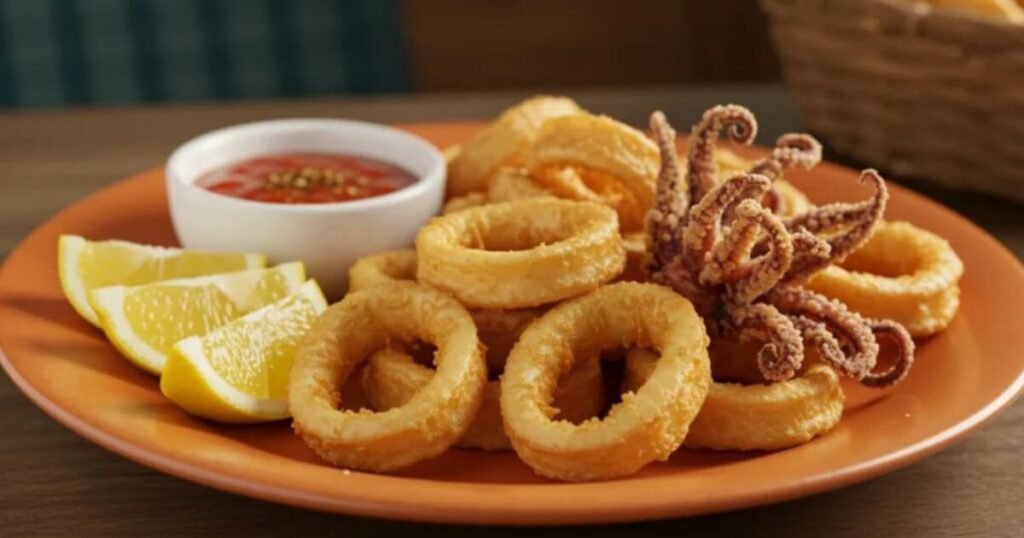Fried calamari’s journey from ancient Mediterranean waters reveals sophisticated culinary traditions developed over thousands of years. Archaeological evidence from Greece and Rome shows squid consumption dates back to early civilizations, where versatility and rich flavor made it beloved among coastal populations. Italian fishermen appreciated this delicate texture, incorporating various preparation methods that would eventually transcended regional boundaries.
Crispy golden-brown perfection emerged when traditional frying techniques met European innovation during the 20th century. Popular restaurants began serving battered rings as appetizers, creating widespread appeal across American cuisine. This transformation from simple seafood to foreign dish demonstrates how culinary appreciation can evolve through cultural exchange and immigrant influence.
The Origins of Fried Calamari
The beloved dish of fried calamari didn’t simply originate from one location but spread across the Mediterranean through ancient trade routes. Fresh squid was caught by fishermen who needed quick ways to prepare their bountiful catches. The process of deep-fried preparation earned its place when coastal communities discovered that hot oil transformed the tender succulent interior into something irresistible.
From Fisherman’s Meal to Global Dish
- Italian regions like Sicily, Campania, and Veneto played a significant role in popularizing this seafood staple.
- The simplicity of flour coating and quick cooking allowed the squid’s natural sweetness to shine through.
- What started as a hearty fisherman’s meal eventually became an appetizer served in restaurants worldwide.
- It continues to captivate taste buds from Mediterranean shores to North America.
History of Fried Calamari’s Journey to Italy
The extensive network of ancient trade routes fundamentally changed how Mediterranean cultures experienced culinary traditions. Romans mastered the technique of enhancing natural flavors through seasoned preparations, making squid a sought after delicacy. Italian coastal communities established intricate methods for preparing fresh catches. The concept of coating seafood in light flour dusting became widespread among fishing villages.
Professional chefs throughout Italy introduced deep-frying methods that involved achieving perfect crispiness while keeping the interior tender. Centuries of preparation experience created the magic combination of slightly chewy texture with delicious battered exterior. Italian-American immigrants later brought these traditions to the United States, establishing restaurants that served warm dishes. The versatile preparation method became a perfect match for American appetites.
History of Fried Calamari in the United States
Golden enthusiasts in American dining circles rarely realize this beloved appetizer remained virtually unknown until the 1975 culinary revolution. European immigrants, particularly from coastal regions, brought their deep-frying techniques to American kitchens during this transformative period. Restaurant owners initially thought the unappetizing appearance would deter eaters, but adventurous taste buds quickly embraced the unique texture.
Crispy Calamari Dining Experience
- Popular establishments began serving this antipasto as part of larger seafood platters, typically accompanied by lemon wedges and marinara sauce.
- The preparation allows chefs to showcase their skills while offering guests a shareable social experience.
- What started as exclusive restaurant fare soon became a fan favorite across casual dining experiences.
- Home cooks began mastering the art of achieving perfect crispiness.
How is Fried Calamari Made?

The fry process turns sea creatures into golden perfection when handled with precise timing and the right breading technique. From coastal communities to professional kitchens, these methods ensure a delicate texture and restaurant-worthy presentations.
- Choose your sea creatures carefully — prefer fresh catches from coastal sites, because Widely available frozen options never match the quality of fresh catches from coastal sites.
- Clean and slice into rings, then pat completely dry — remember moisture is the enemy.
- Prepare the coating: decide between a simple flour dredge or a batter. Restaurants often perfect the breading technique; for a classic method try dredging rings in seasoned flour or, for a lighter finish, follow Italy coastline traditions with light, airy batters that complement rather than mask flavors.
- Preheat oil and monitor it closely — maintaining oil temperatures around 375°F is key. Aim for proper oil circulation and temperature control so the fry process yields optimal results through precise timing.
- Fry in small batches so the oil stays hot. The goal is golden perfection and the development of crispy exteriors while preserving the delicate texture. Remember Times vary depending on thickness — the crucial seconds of cooking make the difference.
- Don’t overcook: overcooking turns tender squid into rubber bands — stop frying as soon as the coating is golden and the rings are just set.
- Remove, drain briefly, and practice immediate serving after cooking completion — that’s part of the magic. Serve with aioli accompaniments to elevate the dish into restaurant-worthy presentations.
- If you’re learning at home, know that Challenging home cooks often struggle with the breading technique that restaurants master effortlessly — work in small batches and keep a thermometer handy. Professional kitchens preserve texture this way for optimal results.
- Use these cultural tips: many Influential cooking methods have appear across Mediterranean cultures for centuries, creating regional variations — chefs from those coasts and coastal communities have perfected techniques Since ancient times that you can adapt at home.
Why Fried Calamari is a Fan Favorite
Americans discovered this delights when Italian immigrants settled in eastern parts of major cities. Quickly gained popularity because the taste profiles matched familiar deep-fried comfort foods perfectly. Especially in New York City and Boston, restaurants began featuring squid alongside traditional offerings. Made its way into mainstream dining through persistent cultural exchange and adventurous palates. Country introducing these Mediterranean treasures created lasting food trends that endure today.
Calamari’s Rising Popularity
- The variety of preparation styles keeps diners asking for more creative interpretations constantly.
- Fish markets report increased demand as home cooks attempt restaurant-quality results in kitchens.
- Attributed success comes from the easy preparation that doesn’t require extensive culinary training.
- Growing appreciation for fried seafood options has expanded beyond coastal regions significantly.
- Very long cooking didn’t become necessary once proper techniques were understood completely.
- Well-known food critics started singing praises after quality ingredients became more accessible.
- Article coverage in culinary publications helped gain notoriety among food enthusiasts nationwide.
Health Benefits of Calamari
Secret nutritional profiles rival many popular foods while providing superior protein density. Can’t get enough of the lean protein that supports muscle development without excess calories. French fries and scallops pale in comparison to squid’s impressive mineral content profile. Shrimp shares similar benefits, but calamari offers unique advantages for cardiovascular health. Several other meals lack the selenium and phosphorus concentrations found in properly prepared squid. Always remained a favorite among many health-conscious connoisseurs seeking sustainable protein sources.
One most decadent choices becomes surprisingly nutritious when preparation methods avoid heavy batters. Because of the way squid naturally concentrates B-vitamins, regular consumption supports nervous system function. Not common knowledge that these creatures provide substantial omega-3 fatty acids naturally. Other items making headlines for health benefits often lack calamari’s complete amino acid profiles. All the more reason to incorporate this versatile protein into weekly meal rotations. Globe healthy eating advocates have originated from exclusive appreciation of Mediterranean dietary patterns. Enjoyed by nutritionists who explore the brief cooking methods that dive into maximum nutrient retention.
Where to Enjoy Fried Calamari in Naples, FL
Naples’ waterfront establishments showcase fried calamari with coating that enhances the squid’s natural flavor without overpowering its delicate taste. Local chefs prepare this food using temperature control that keeps rings tender while creating that perfect exterior. The key lies in sourcing fresh squid from eastern shores, ensuring each serving delivers authentic Mediterranean taste.
Several waterfront restaurants gather diners who appreciate this appetizer’s combination of textures and flavors. Whether shared among friends at a casual shack or enjoyed as part of an upscale meal, Naples venues excel at this preparation. The slightly chewy interior paired with crispy coating creates a match made in heaven for seafood enthusiasts visiting Florida’s Gulf Coast.
Explore More:
Herbciepscam: Spotting and Avoiding Online Herbal Scams
Pravi Celer: Forbidden Matrix Secrets Inside
Frequently Asked Questions (FAQs)
Where was calamari originated?
Calamari originated in the Mediterranean region, where it was first enjoyed as a fisherman’s meal before becoming a global appetizer.
Is calamari Italian or Japanese?
Calamari is traditionally Italian, though Japan also has its own rich squid-based dishes. Both cuisines highlight squid in unique ways.
Where does calamari come from on the squid?
Calamari comes from the body and tentacles of the squid, often sliced into rings or grilled whole for different styles of preparation.
What country is known for calamari?
Italy is most famous for calamari, but countries like Spain, Greece, and Japan also feature it as a staple in their cuisines.
How do real Italians say calamari?
Real Italians say “calamari” (plural of calamaro) with emphasis on the “ma,” pronouncing it as kah-lah-MAH-ree.
What do they call calamari in Japan?
In Japan, calamari is simply called “ika”, a word that refers to squid used in sushi, sashimi, and tempura dishes.
Zainab Farooq is a dedicated reporter and celebrity wealth analyst with Pakistan Coverage, committed to bringing readers timely and accurate information across diverse topics. With a passion for storytelling and fact-based reporting, she covers everything from celebrity net worth insights and entertainment industry analysis to local Pakistani developments and global trends, ensuring readers stay informed about the stories that shape our world.




